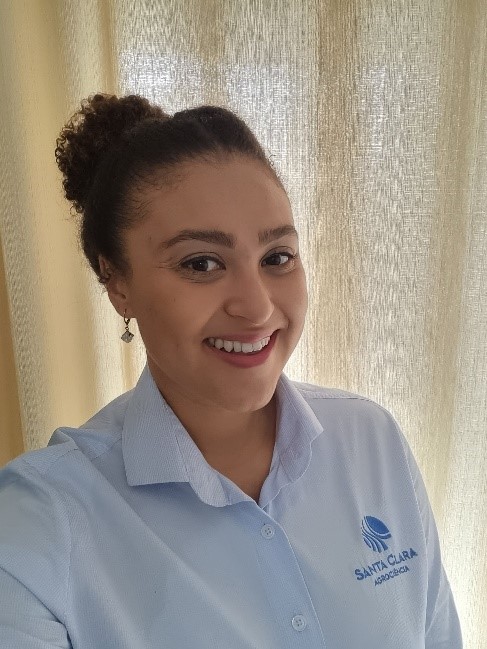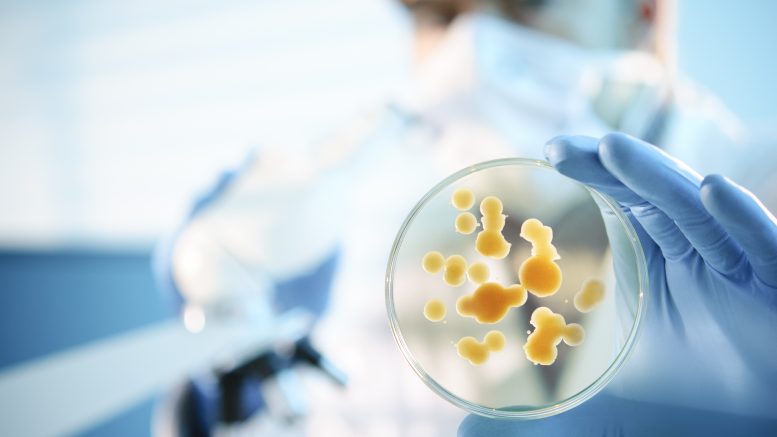“Currently, efforts are focused on prospecting new microbial strains, obtaining plant extracts…”
Paloma Liborio is a research analyst at Santa Clara Agrociência, graduated in agronomy from the Centro Universitário da Fundação Educacional de Barretos, M.Sc. in genetics and plant breeding from Unesp, and Ph.D. in agronomy from UEL and Embrapa Soybean, included among the 100 women with Ph.D’s in agribusiness in 2023 by Forbes.

Paloma Liborio, research analyst at Santa Clara Agrociência
AgriBrasilis – How is the bioinputs R&D process carried out? How long does it take for a new biological solution to reach the market?
Paloma Liborio – The Research and Development process of a bioinput includes the research and identification of new biological assets, the development of a formulation, carrying out efficacy tests in controlled environments and in the farms, as well as safety analysis, the approval and registration with the regulatory agencies, MAPA, Anvisa, and Ibama.
In the current Brazilian regulatory context, biologicals intended for controlling pests, diseases and nematodes are subject to the same legislation as pesticides, according to Law No. 7802. However, the time required for a biological solution to reach the Brazilian market is significantly shorter when compared to chemical pesticides.
On average, introducing a new biological product can take around three years, depending on complexity, specificity, and regulatory requirements. Chemical pesticides require a period of approximately seven years until they are available to the market.
AgriBrasilis – What is the state of the art in bioinput research? What new developments are likely to appear on the market in the short and medium term?
Paloma Liborio – Research in bioinputs is constantly evolving and expanding. Currently, efforts are focused on prospecting new microbial strains, obtaining plant extracts and improving existing formulations.
In the short and medium term, we envision the continued development of more effective and specific solutions for different crops, significant advances in understanding the interactions between microorganisms and plants, and regulations that accompany the growth in the adoption of bioinputs, as sustainability becomes a global priority.
Furthermore, some points are worth highlighting:
- The current base of microorganisms present in bioinputs is still limited. There is a vast potential to be explored and in the prospecting phase for the production of new products.
- Increase in the use of active ingredients generated by microorganisms and their metabolites. This approach aims to optimize the production and effectiveness of bioinputs, taking advantage of the full potential of microorganisms.
- Investments more focused on improving bio-based products. This approach involves the application of advanced technology in formulations, seeking greater compatibility of bioinputs with other products, in addition to promoting a significant increase in the lifespan of these products.
- Advanced molecular biology techniques for activating the metabolic pathways of microorganisms to maximize the benefits of bioinputs, improving effectiveness and adaptability to diverse environments and cultures.
AgriBrasilis – Is the bioinputs “boom” in agriculture bringing more researchers to the market? Why?
Paloma Liborio – Bioinputs offer many opportunities for professionals from different areas. This market has the potential to reach US$ 10 billion by 2030. This growth has generated a high demand for highly qualified professionals, leading companies to look for professionals with M.Sc degrees and Ph.Ds, for example.
The industry is moving towards greater professionalization and the development of new formulations and technologies. This move aligns with closer collaboration with universities and research institutions. In this context, researchers find a dynamic and technological environment to conduct research in the private sector, which has contributed to attracting talent to companies.
Collaboration between the private sector, universities and research institutions is already a reality in Brazil, and tends to expand even further. Strengthening synergy between these sectors plays a crucial role in boosting the country’s economic development.
AgriBrasilis – Is the bioinput professional more concerned about sustainability?
Paloma Liborio – As a professional in the area of bioinputs, I experience its benefits and positive impacts on crops and the environment. Bioinputs are a more ecological alternative, derived from natural sources, and cause less environmental impact when compared to conventional chemical products.
The emphasis on sustainability reflects a deeper understanding of the environmental, social and economic challenges facing our planet. As citizens and professionals, we have a crucial role in finding solutions that reconcile our present needs with the life of future generations.
These concerns align with the principles of ESG (Environmental, Social, and Governance), which encompass the implementation of sustainable practices, respect for the environment, the promotion of social well-being and a guarantee of ethical and transparent governance.
“On average, introducing a new biological product can take around three years”
AgriBrasilis – What is the Santa Clara Group’s market? What investments does the company plan for the coming years?
Paloma Liborio – The Santa Clara Group has been in the market for over 50 years, concentrating its operations in the special fertilizers and plant protection markets. The segments in which the company is involved are considered as high-tech inputs, with total market revenue estimated at US$ 6.3 billion in the 2023/24 season.
For the next few years, the company includes in its strategic planning the launch of 16 new biopesticide products, with significant investment in its biological pesticide company, Inflora Biociências. In order to support this growth, we will build a facility in an area of 40 hectares, comprising an industrial unit and an Innovation Center and Technological Showcase. This project is part of a total investment of US$ 25 million, of which US$ 20 million will be allocated to the new biopesticide industrial unit.
In addition to investments in Inflora, the Santa Clara Group is in the process of expanding its main industrial unit, with a 100% increase in its area and a 248% increase in its fertilizer shipping capacity.
READ MORE:

